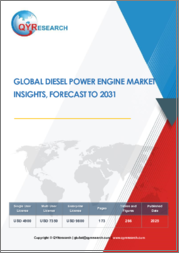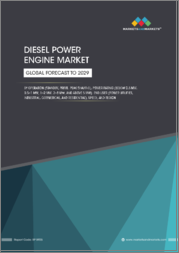
|
시장보고서
상품코드
1662604
세계의 디젤 엔진 시장(-2030년) : 연료 유형, 엔진 유형, 컴포넌트, 용도, 지역별 예측 및 분석Diesel Power Engine Market Forecasts to 2030 - Global Analysis By Fuel Type (Conventional Diesel, Biodiesel, Natural Gas and Other Fuel Types), Engine Type, Component, Application and By Geography |
||||||
Stratistics MRC에 따르면 디젤 엔진 세계 시장은 2024년에 80억 1,000만 달러를 달성하였고 2030년에는 145억 8,000만 달러에 이를 것으로 예측되며 예측 기간 중 CAGR은 8.6%입니다.
디젤 엔진은 디젤 연료를 연료로 사용하는 내연 기관입니다. 압축을 통해 공기와 연료의 혼합기를 점화하기 때문에 가솔린 엔진보다 효율이 높습니다. 엔진은 실린더 내의 공기를 압축하여 열을 발생시키고 압축 공기에 디젤 연료를 분사하여 작동합니다. 이 과정을 통해 다양한 용도의 전력 발전이 이루어집니다.
중국국가통계국에 따르면 이 나라의 디젤연료소비량은 2023년 1억 6,700만톤에 달하였으며 2022년보다 5% 증가했습니다.
대형차 수요 증가
디젤 엔진은 물류, 건설, 광업과 같은 산업에 필수적인 높은 토크와 연료 효율을 제공하며 높은 하중 처리 및 장거리 이동에 필수적입니다. 또한, 디젤 엔진은 내구성, 낮은 운영 비용, 가혹한 조건에서의 운전 능력으로 알려져 있으며 대형 응용 분야에 이상적입니다. 세계 무역과 인프라 개발이 진행됨에 따라 디젤 엔진을 탑재한 대형 차량 수요는 계속 확대될 것으로 예상됩니다.
전기자동차로의 전환 증가
소비자와 기업이 환경친화적인 대안을 수락함에 따라 각국 정부는 보다 엄격한 배출 기준을 도입하고 전기차 도입의 인센티브를 제공합니다. 이 전환은 자동차 섹터에서 디젤 엔진의 필요성을 제한할 뿐만 아니라 상업 및 산업용도에서 보다 깨끗한 에너지 솔루션으로의 전환을 가속화하고 있습니다. EV 인프라가 성장하고 배터리 기술이 향상됨에 따라 디젤 엔진 시장은 경쟁의 격화와 규제 문제에 직면하고 있고 이는 시장 확대를 방해하고 있습니다.
인프라 개발 증가
디젤 엔진은 크레인, 굴삭기, 불도저, 트럭 등 대규모 인프라 프로젝트에 필수적인 장비에 널리 사용됩니다. 또한, 디젤 엔진은 가혹한 조건에서 운전에 필요한 신뢰성과 파워를 제공합니다. 정부와 비공개 회사가 도로, 다리, 도시 개발, 에너지 인프라 건설에 많은 투자를 하고 있기 때문에 견고하고 효율적인 디젤 엔진 탑재 기계에 대한 수요는 증가 추세에 있으며 이는 시장 확대의 원동력이 되고 있습니다.
높은 초기 비용
디젤 엔진은 고압축 실린더, 터보차저, 첨단 연료 분사 시스템 등 효율과 내구성을 향상시키는 데 필요한 복잡한 부품을 탑재하여 초기 비용이 높습니다. 게다가 높은 응력 레벨에 대응하기 때문에 보다 견고한 재료가 요구되는 경우가 많습니다. 그 결과, 디젤 엔진은 가솔린 엔진이나 신흥 전기자동차와 같은 저비용 대체품에 비해 매력이 낮기 때문에 선행 투자가 기피되고 이는 시장 성장을 방해하게 됩니다.
COVID-19의 영향
COVID-19의 유행은 디젤 엔진 시장에 다양한 영향을 미쳤습니다. 초기 봉쇄 기간 동안 운송 및 건설과 같은 부문에서 디젤 엔진 수요는 운영 중단 및 공급망 혼란으로 인해 감소했습니다. 그러나 경제가 회복되기 시작하면서 인프라 프로젝트에 견인되어 디젤 상용차와 기계에 대한 수요가 급증했습니다. 하지만 장기적으로는 더 깨끗한 대체 연료로의 전환이 진행되고 배기가스 규제가 강화되어 시장 성장성이 둔화될 수 있습니다.
예측 기간 동안 다기통 부문이 최대로 성장할 전망
다기통 부문은 예측 기간 동안 최대 시장 점유율을 확보할 것으로 예측됩니다. 다기통 디젤 엔진은 출력, 연료 효율 및 엔진 성능을 향상시키기 위해 일반적으로 4 기통에서 12 기통까지 여러 개의 실린더를 갖추고 있습니다. 엔진의 작업량을 여러 실린더에 분산시킴으로써 이러한 엔진은 높은 토크를 발생시킬 수 있으며 높은 내구성을 필요로 하는 용도에 이상적입니다. 이러한 엔진은 신뢰성, 연비 효율, 보다 큰 부하를 처리할 수 있는 능력으로 알려져 있으며 까다로운 산업 부문과 운송 부문에 매우 중요합니다.
예측 기간 동안 CAGR이 가장 높을 것으로 예상되는 자동차 부문
자동차 부문은 예측 기간 동안 가장 높은 CAGR이 예상됩니다. 디젤 엔진은 뛰어난 연비 효율과 높은 토크 출력으로 자동차 용도, 특히 트럭, 버스, SUV 등의 대형 차량에 널리 사용됩니다. 이 엔진은 가솔린 엔진에 비해 연비가 좋고 장거리 이동 및 상업 운송에 이상적입니다. 디젤 엔진은 견인 능력을 향상시키고 복잡한 도로 상황에 적합합니다.
최대 점유율을 차지하는 지역
아시아태평양은 급속한 산업화, 수송 수요 증가 및 인프라 정비로 인해 예측 기간 동안 최대 시장 점유율을 기록할 것으로 예상됩니다. 중국, 인도, 일본 등의 국가들은 대형차, 건설기계, 산업기계에 디젤 엔진을 공급하고 있어 시장에 큰 공헌을 하고 있습니다. 이 지역은 디젤 엔진에 의존하는 많은 상업 부문과 농업 부문에서 이익을 얻고 있습니다. 이 시장은 진행 중인 인프라 프로젝트와 산업의 요구에 힘입어 꾸준한 성장이 예상됩니다.
CAGR이 가장 높은 지역
북미는 디젤 상용차, 산업기계, 발전설비에 대한 왕성한 수요에 견인되어 예측 기간 중 가장 높은 CAGR이 예상됩니다. 미국과 캐나다는 주요 시장이며 디젤 엔진은 높은 토크와 연비 효율 때문에 특히 운송 및 건설 부문에서 선호됩니다. 또한 에너지 안보와 인프라 개발에 중점을 둔 이 지역은 시장의 성장을 뒷받침하고 있습니다.
무료 맞춤형 서비스
이 보고서를 구독하는 고객에게는 다음 무료 맞춤형 옵션 중 하나가 제공됩니다.
- 기업 프로파일
- 추가 시장 진출기업의 종합적 프로파일링(최대 3개사)
- 주요 기업의 SWOT 분석(최대 3개사)
- 지역 세분화
- 고객의 관심에 맞춘 주요국 시장 추정, 예측 및 CAGR(주 : 타당성 분석에 따름)
- 경쟁 벤치마킹
- 제품 포트폴리오, 지리적 존재, 전략적 제휴를 통한 주요 기업 벤치마킹
목차
제1장 주요 요약
제2장 서문
- 개요
- 이해관계자
- 조사 범위
- 조사 방법
- 데이터 마이닝
- 데이터 분석
- 데이터 검증
- 조사 접근
- 조사 정보원
- 1차 조사 정보원
- 2차 조사 정보원
- 전제조건
제3장 시장 동향 분석
- 소개
- 성장 촉진요인
- 성장 억제요인
- 기회
- 위협
- 용도 분석
- 신흥 시장
- COVID-19의 영향
제4장 Porter's Five Forces 분석
- 공급기업의 협상력
- 구매자의 협상력
- 대체품의 위협
- 신규 참가업체의 위협
- 경쟁 기업간 경쟁 관계
제5장 세계의 디젤 엔진 시장 : 연료 유형별
- 소개
- 기존 디젤
- 바이오디젤
- 천연가스
- 기타
제6장 세계의 디젤 엔진 시장 : 엔진 유형별
- 소개
- 단기통
- 다기통
제7장 세계의 디젤 엔진 시장 : 컴포넌트별
- 소개
- 엔진 블록
- 실린더 헤드
- 크랭크축
- 연료 분사 시스템
- 터보차저
- 배기 시스템
- 냉각 시스템
- 기타
제8장 세계의 디젤 엔진 시장 : 용도별
- 소개
- 자동차
- 해양
- 건설기계
- 농업
- 발전
- 철도
- 공업 및 상업용
- 광업
- 기타
제9장 세계의 디젤 엔진 시장 : 지역별
- 소개
- 북미
- 미국
- 캐나다
- 멕시코
- 유럽
- 독일
- 영국
- 이탈리아
- 프랑스
- 스페인
- 기타 유럽
- 아시아태평양
- 일본
- 중국
- 인도
- 호주
- 뉴질랜드
- 한국
- 기타 아시아태평양
- 남미
- 아르헨티나
- 브라질
- 칠레
- 기타 남미
- 중동 및 아프리카
- 사우디아라비아
- 아랍에미리트(UAE)
- 카타르
- 남아프리카
- 기타 중동 및 아프리카
제10장 주요 개발
- 계약/파트너십/협업/합작투자(JV)
- 인수 및 합병
- 신제품 발매
- 사업 확대
- 기타 주요 전략
제11장 기업 프로파일링
- Caterpillar Inc.
- Cummins Inc.
- Rolls-Royce Holdings plc
- Mitsubishi Heavy Industries Limited
- Wartsila Corporation
- Volvo Group
- Kohler Corporation
- Perkins Engines Company Limited
- Hitachi Corporation
- Komatsu Corporation
- Greaves Cotton Limited
- John Deere & Company
- MAN Energy Solutions
- MTU Friedrichshafen GmbH
- Yanmar Corporation
- Deutz AG
- 두산인프라코어 Corporation
- Scania AB
- Hatz Diesel
- Weichai Power Corporation
According to Stratistics MRC, the Global Diesel Power Engine Market is accounted for $8.01 billion in 2024 and is expected to reach $14.58 billion by 2030 growing at a CAGR of 8.6% during the forecast period. A Diesel Power Engine is an internal combustion engine that runs on diesel fuel. It uses compression to ignite the air-fuel mixture, making it more efficient than gasoline engines. The engine operates by compressing air in a cylinder, causing the air to heat up, and then injecting diesel fuel into the compressed air, which ignites due to the high temperature. This process results in power generation for various applications.
According to China's National Bureau of Statistics, diesel fuel consumption in the country reached 167 million tons in 2023, a 5% increase from 2022.
Market Dynamics:
Driver:
Rising demand for heavy-duty vehicles
Diesel engines provide higher torque and fuel efficiency, essential for heavy-load handling and long-distance travel, which is vital for industries like logistics, construction, and mining. Additionally, diesel engines are known for their durability, low operating costs, and ability to operate under demanding conditions, making them ideal for heavy-duty applications. As global trade and infrastructure development grow, the demand for diesel-powered heavy-duty vehicles is expected to continue expanding.
Restraint:
Increasing shift toward electric vehicles
As consumers and businesses embrace environmentally friendly alternatives, governments are implementing stricter emission standards and offering incentives for EV adoption. This shift not only limits the need for diesel engines in the automotive sector but also accelerates the transition toward cleaner energy solutions in commercial and industrial applications. As EV infrastructure grows and battery technology improves, the diesel engine market faces increased competition and regulatory challenges, hindering its expansion.
Opportunity:
Increase in infrastructure development
Diesel engines are widely used in equipment such as cranes, excavators, bulldozers, and trucks, which are essential for large-scale infrastructure projects. Additionally, diesel engines provide the reliability and power needed to operate in tough conditions. As governments and private companies invest heavily in building roads, bridges, urban developments, and energy infrastructure, the demand for robust and efficient diesel-powered machines continues to rise, driving the market's expansion.
Threat:
Higher upfront cost
Diesel Power Engines have a higher upfront cost due to their complex components, such as high-compression cylinders, turbochargers, and advanced fuel injection systems, which are required for better efficiency and durability. Additionally, they often require more robust materials to handle higher stress levels. As a result, the higher upfront investment hampers market growth by making diesel engines less attractive compared to lower-cost alternatives like gasoline engines or emerging electric vehicles.
Covid-19 Impact
The covid-19 pandemic had a mixed impact on the diesel power engine market. During the initial lockdowns, demand for diesel engines in sectors like transportation and construction declined due to halted operations and supply chain disruptions. However, as economies began recovering, the demand for diesel-powered commercial vehicles and machinery surged driven by infrastructure projects. Long-term, there is a growing shift towards cleaner alternatives and tighter emission regulations, which may dampen the market's growth potential.
The multi-cylinder segment is expected to be the largest during the forecast period
The multi-cylinder segment is predicted to secure the largest market share throughout the forecast period. Multi-cylinder diesel engines feature multiple cylinders, typically ranging from 4 to 12, to enhance power output, fuel efficiency, and engine performance. By distributing the engine's workload across several cylinders, these engines can generate higher torque, which is ideal for heavy-duty applications. These engines are known for their reliability, fuel efficiency, and ability to handle larger loads, making them crucial for demanding industrial and transportation sectors.
The automotive segment is expected to have the highest CAGR during the forecast period
The automotive segment is anticipated to witness the highest CAGR during the forecast period. Diesel power engines are widely used in automotive applications, particularly for heavy-duty vehicles like trucks, buses, and SUVs, due to their superior fuel efficiency and high torque output. These engines offer better fuel economy compared to gasoline engines, making them ideal for long-distance travel and commercial transportation. Diesel engines provide enhanced towing capabilities and are well-suited for demanding road conditions.
Region with largest share:
Asia Pacific is expected to register the largest market share during the forecast period due to rapid industrialization, increasing demand for transportation, and infrastructure development. Countries like China, India, and Japan are major contributors, with diesel engines powering heavy-duty vehicles, construction equipment, and industrial machinery. The region benefits from a large number of commercial and agricultural sectors relying on diesel-powered engines. The market is expected to witness steady growth, fueled by ongoing infrastructure projects and industrial needs.
Region with highest CAGR:
North America is expected to witness the highest CAGR over the forecast period driven by the strong demand for diesel-powered commercial vehicles, industrial machinery, and power generation equipment. The U.S. and Canada are key markets, where diesel engines are preferred for their high torque and fuel efficiency, particularly in the transportation and construction sectors. Additionally, the region's focus on energy security and infrastructure development supports market growth.
Key players in the market
Some of the key players profiled in the Diesel Power Engine Market include Caterpillar Inc., Cummins Inc., Rolls-Royce Holdings plc, Mitsubishi Heavy Industries Limited, Wartsila Corporation, Volvo Group, Kohler Corporation, Perkins Engines Company Limited, Hitachi Corporation, Komatsu Corporation, Greaves Cotton Limited, John Deere & Company, MAN Energy Solutions, MTU Friedrichshafen GmbH, Yanmar Corporation, Deutz AG, Doosan Infracore Corporation, Scania AB, Hatz Diesel and Weichai Power Corporation.
Key Developments:
In January 2025, Cummins has launched the next-generation 6.7L Turbo Diesel engine system for the 2025 Ram Heavy Duty Trucks, further solidifying its longstanding partnership with Ram Trucks. This new engine system is designed to offer significant performance, fuel efficiency, and emissions improvements, building on the success of their 35-year collaboration.
In April 2024, Weichai Power made a significant breakthrough in diesel engine technology by unveiling the world's first diesel engine with a base engine brake thermal efficiency of 53.09%. This efficiency is significantly higher than the typical efficiency of traditional diesel engines, which is generally around 40-45%.
Fuel Types Covered:
- Conventional Diesel
- Biodiesel
- Natural Gas
- Other Fuel Types
Engine Types Covered:
- Single Cylinder
- Multi-Cylinder
Components Covered:
- Engine Block
- Cylinder Head
- Crankshaft
- Fuel Injection System
- Turbocharger
- Exhaust Systems
- Cooling System
- Other Components
Applications Covered:
- Automotive
- Marine
- Construction Equipment
- Agriculture
- Power Generation
- Railways
- Industrial & Commercial Use
- Mining
- Other Applications
Regions Covered:
- North America
- US
- Canada
- Mexico
- Europe
- Germany
- UK
- Italy
- France
- Spain
- Rest of Europe
- Asia Pacific
- Japan
- China
- India
- Australia
- New Zealand
- South Korea
- Rest of Asia Pacific
- South America
- Argentina
- Brazil
- Chile
- Rest of South America
- Middle East & Africa
- Saudi Arabia
- UAE
- Qatar
- South Africa
- Rest of Middle East & Africa
What our report offers:
- Market share assessments for the regional and country-level segments
- Strategic recommendations for the new entrants
- Covers Market data for the years 2022, 2023, 2024, 2026, and 2030
- Market Trends (Drivers, Constraints, Opportunities, Threats, Challenges, Investment Opportunities, and recommendations)
- Strategic recommendations in key business segments based on the market estimations
- Competitive landscaping mapping the key common trends
- Company profiling with detailed strategies, financials, and recent developments
- Supply chain trends mapping the latest technological advancements
Free Customization Offerings:
All the customers of this report will be entitled to receive one of the following free customization options:
- Company Profiling
- Comprehensive profiling of additional market players (up to 3)
- SWOT Analysis of key players (up to 3)
- Regional Segmentation
- Market estimations, Forecasts and CAGR of any prominent country as per the client's interest (Note: Depends on feasibility check)
- Competitive Benchmarking
- Benchmarking of key players based on product portfolio, geographical presence, and strategic alliances
Table of Contents
1 Executive Summary
2 Preface
- 2.1 Abstract
- 2.2 Stake Holders
- 2.3 Research Scope
- 2.4 Research Methodology
- 2.4.1 Data Mining
- 2.4.2 Data Analysis
- 2.4.3 Data Validation
- 2.4.4 Research Approach
- 2.5 Research Sources
- 2.5.1 Primary Research Sources
- 2.5.2 Secondary Research Sources
- 2.5.3 Assumptions
3 Market Trend Analysis
- 3.1 Introduction
- 3.2 Drivers
- 3.3 Restraints
- 3.4 Opportunities
- 3.5 Threats
- 3.6 Application Analysis
- 3.7 Emerging Markets
- 3.8 Impact of Covid-19
4 Porters Five Force Analysis
- 4.1 Bargaining power of suppliers
- 4.2 Bargaining power of buyers
- 4.3 Threat of substitutes
- 4.4 Threat of new entrants
- 4.5 Competitive rivalry
5 Global Diesel Power Engine Market, By Fuel Type
- 5.1 Introduction
- 5.2 Conventional Diesel
- 5.3 Biodiesel
- 5.4 Natural Gas
- 5.5 Other Fuel Types
6 Global Diesel Power Engine Market, By Engine Type
- 6.1 Introduction
- 6.2 Single Cylinder
- 6.3 Multi-Cylinder
7 Global Diesel Power Engine Market, By Component
- 7.1 Introduction
- 7.2 Engine Block
- 7.3 Cylinder Head
- 7.4 Crankshaft
- 7.5 Fuel Injection System
- 7.6 Turbocharger
- 7.7 Exhaust Systems
- 7.8 Cooling System
- 7.9 Other Components
8 Global Diesel Power Engine Market, By Application
- 8.1 Introduction
- 8.2 Automotive
- 8.3 Marine
- 8.4 Construction Equipment
- 8.5 Agriculture
- 8.6 Power Generation
- 8.7 Railways
- 8.8 Industrial & Commercial Use
- 8.9 Mining
- 8.10 Other Applications
9 Global Diesel Power Engine Market, By Geography
- 9.1 Introduction
- 9.2 North America
- 9.2.1 US
- 9.2.2 Canada
- 9.2.3 Mexico
- 9.3 Europe
- 9.3.1 Germany
- 9.3.2 UK
- 9.3.3 Italy
- 9.3.4 France
- 9.3.5 Spain
- 9.3.6 Rest of Europe
- 9.4 Asia Pacific
- 9.4.1 Japan
- 9.4.2 China
- 9.4.3 India
- 9.4.4 Australia
- 9.4.5 New Zealand
- 9.4.6 South Korea
- 9.4.7 Rest of Asia Pacific
- 9.5 South America
- 9.5.1 Argentina
- 9.5.2 Brazil
- 9.5.3 Chile
- 9.5.4 Rest of South America
- 9.6 Middle East & Africa
- 9.6.1 Saudi Arabia
- 9.6.2 UAE
- 9.6.3 Qatar
- 9.6.4 South Africa
- 9.6.5 Rest of Middle East & Africa
10 Key Developments
- 10.1 Agreements, Partnerships, Collaborations and Joint Ventures
- 10.2 Acquisitions & Mergers
- 10.3 New Product Launch
- 10.4 Expansions
- 10.5 Other Key Strategies
11 Company Profiling
- 11.1 Caterpillar Inc.
- 11.2 Cummins Inc.
- 11.3 Rolls-Royce Holdings plc
- 11.4 Mitsubishi Heavy Industries Limited
- 11.5 Wartsila Corporation
- 11.6 Volvo Group
- 11.7 Kohler Corporation
- 11.8 Perkins Engines Company Limited
- 11.9 Hitachi Corporation
- 11.10 Komatsu Corporation
- 11.11 Greaves Cotton Limited
- 11.12 John Deere & Company
- 11.13 MAN Energy Solutions
- 11.14 MTU Friedrichshafen GmbH
- 11.15 Yanmar Corporation
- 11.16 Deutz AG
- 11.17 Doosan Infracore Corporation
- 11.18 Scania AB
- 11.19 Hatz Diesel
- 11.20 Weichai Power Corporation




















